Order by 3 PM CT for Same-Day Free Shipping (Lower 48 | Mon-Fri)
What about sharks? A question most kayak anglers get asked regularly and are often one of the first cautions in the mind of a first-time kayak fisherman. Offshore kayak anglers often have a higher chance of encountering sharks, so we checked in with Hawaii based Pro Staffer, Dan of Flying Fish TV, to ask a few questions about his encounters with sharks over the years and is it really a concern.
Kayak Fishing in Hawaii often involves dealing with sharks
Dan is blessed to be living in a blue water anglers paradise regularly boating fish species that would be a once in a lifetime capture for most, like Pacific Blue Marlin, Wahoo, Mahi Mahi, Yellowfin tuna and more… and all from his Hobie kayak. We asked Dan a series of questions to get a better understanding of the real risk of sharks and kayak fishing and how he manages it.

I bought my first kayak in 2013 after going to Army flight school in Alabama. It was a 2-hour drive to hit the Gulf of Mexico. Any chance I could make it down there I would, but I really didn’t know anything about kayak fishing. My time came to an end I would spend the next 5 years without fishing off my kayak.
Between deployments or the unfortunate experience of being stationed in Kansas other interests drew my attention. It wasn’t until 2017 when my wife got orders to Hawaii that I really had any plans of kayak fishing. I knew it would be an opportunity that I wasn’t going to waste. It looked so easy, but I would come to find that it was anything but.
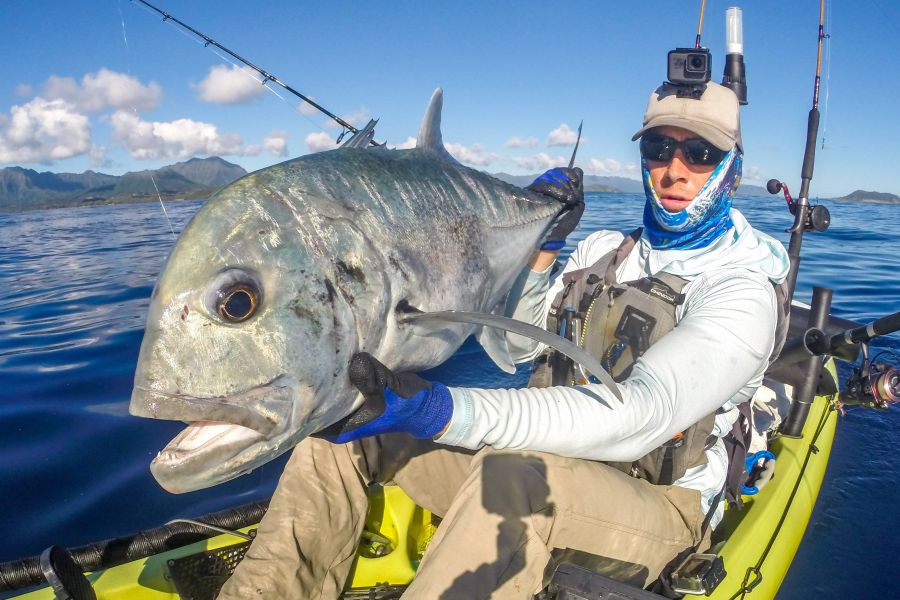
Kayak Fishing Hawaii Trevally
I have found that sharks often have a bad reputation and the less people know about them the more their imaginations run wild. These aren’t your cute little cuddly 3 or 4-foot sharks; they are almost always bigger than 7 feet long with the biggest I have encountered over 20ft.
Out of the 40 species sharks in Hawaii the 4 most commonly sighted are the white tip reef shark, sandbar shark, scalloped hammerhead, and the tiger shark. Sharks are an important part of the ecosystem responsible for maintaining its health through predation. I commonly run into sandbar and tiger sharks, while less frequently hammerheads and Galapagos sharks.
Most of my shark encounters has been spent fighting off sandbar sharks attempting to eat my yellowfin tuna. Soon after I caught my first yellowfin tuna, I encountered my first sandbar shark. I had hooked my biggest yellowfin tuna to date (around 30lbs) and I had no idea how much pressure to put on the fish.
In 150ft it ran straight for the bottom and was down there shaking the way your live bait does before being eaten. At 75ft down the fish started coming much easier and I found the reason soon enough. A 7ft sandbar shark was latched on to my fish and the second it hit the surface (right next to the kayak) it bit the fish in half and shot off making a large splash. Needless to say, I was a little shaken up.
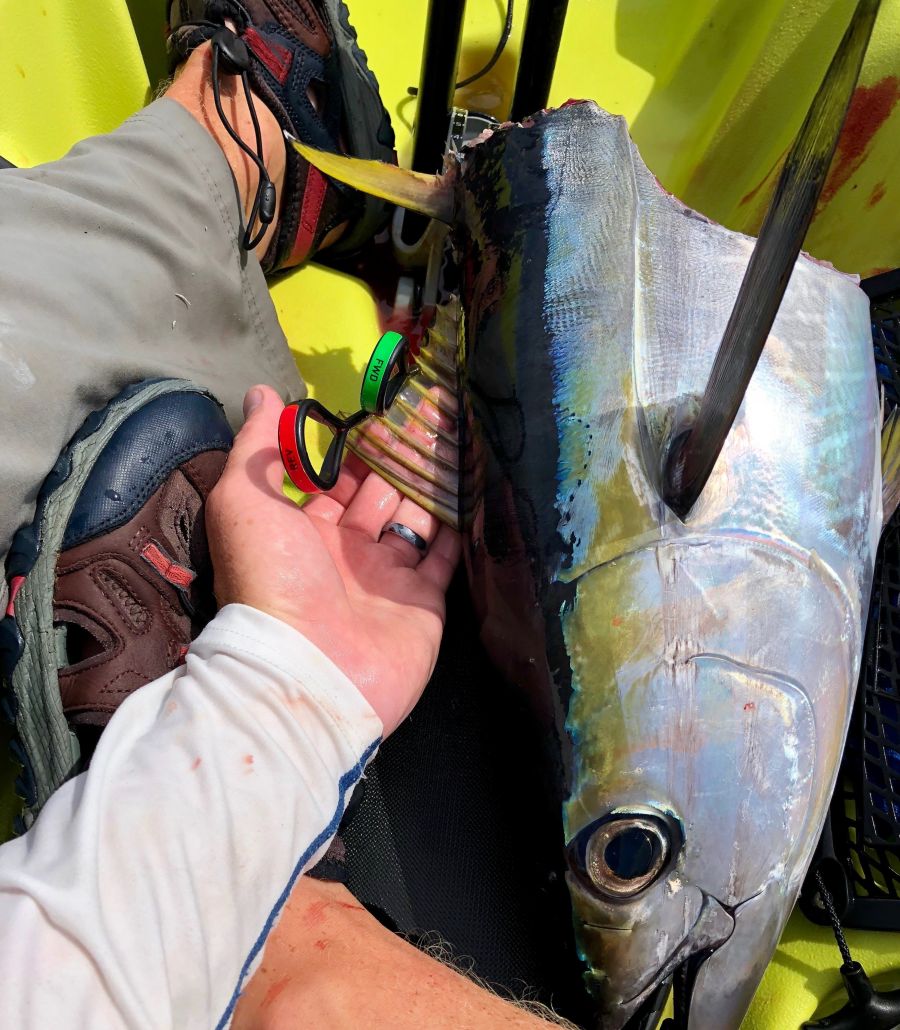
Yellowfin Tuna half is eaten by a shark while kayak fishing
Sandbar sharks follow the schools of opleu or mackerel scad and the yellowfin tuna feed off the opleu schools. Mackerel scad is often regarded as the best bait in the ocean and that is certainly the case here in Hawaii. A typical day targeting yellowfin starts live baiting around the schools of opleu in the 150-250ft of water.
After hooking a yellowfin it will run to the bottom frantically trying to escape. In its desperation, it emits a vibration that attracts sharks. In my case, I often get fish to the side of the kayak where they go nuts on the surface of the water. The proverbial ringing of the dinner bell as I try to subdue them with my Hawaiian spear gaff.
After sandbar sharks eat your fish they will sometimes come up looking around the kayak for something else to eat. This is often innocuous and after a few circles, they retreat to the depths. Overall sandbar sharks while annoying are mostly harmless and they only come around on about 25% of trips to sample the sashimi.

Tiger sharks are responsible for most of the attacks in Hawaii
Tiger sharks are responsible for most of the attacks in Hawaii. On around 15 % of trips, I run into tiger sharks. With one exception they have been nothing more than inquisitive with me. Most often I will see them cruising out in 200 ft about 5ft below the surface.
The exception was in shallow water (60ft) when I was trying to catch bait. It was blowing about 15 knots and I was facing into the waves catching goatfish. I had just turned on the camera mounted to my camera Boom 600, to comment on a goatfish when I heard what sounded like a breaking wave coming from behind me. In the moment all I saw was a big wide head and the tail as it disappeared below the surface.
On the footage, I would see an 8-10ft tiger that was about to eat my rudder. Tiger sharks are known for attacking turtles in shallow water and the rudder on my Hobie revolution looks just like a turtle flipper. Thankfully it turned off at the last second, shooting alongside the kayak. That experience still scares me for spearfishing, which I am just getting into. Most of the tiger sharks I come across tend to be around 10ft long with the biggest around 16 ft.
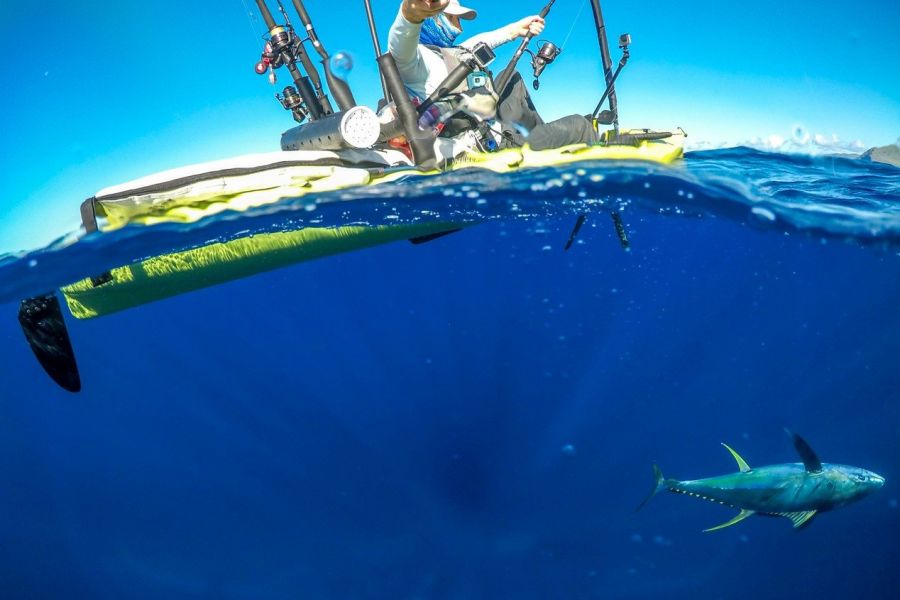
One Yellowfin Tuna that escaped the jaws of a shark
Galapagos sharks are also known to be aggressive and that has been my experience. The first one I ever hooked jumped like a marlin on the surface before diving down. After a hard fight around 10 minutes later, I was able to break it off. If you go on a cage dive on the north shore Galapagos sharks will be swimming around the cage. With the exception of the first Galapagos that I hooked most of the other ones have been smaller in the 3-5ft range.
I have only seen a few hammerheads, but they are pretty freaky. On one of my first trips in Hawaii, I saw a 3ft dorsal fin sticking out of the water around 20ft away from me. I tried to ignore it in disbelief but later on, my friend told me that it was a 20ft plus hammerhead. On another occasion, I was towed out by a 15ft hammerhead from 100ft to over 700ft. It didn’t fight like any of the other sharks I have mentioned. I got it to around 30ft from the kayak before my 30lb broke.

Kayak fishing hooked up and a shark has taken my tuna
Much like you read the action of your live bait you have to interpret the movement of the tuna while you fight it. You can attempt to beat sandbar sharks at their own game by free lining after you have hooked them to try and shake them off (only if you think sharks are about to attack your fish).
Another tactic is to drag them to deeper water. When a sandbar shark hits your fish it often feels like the line was caught on the pectoral fin and then popped loose. There is the chance that the fish will get away while free lining, but I would rather that than the shark getting a free meal.
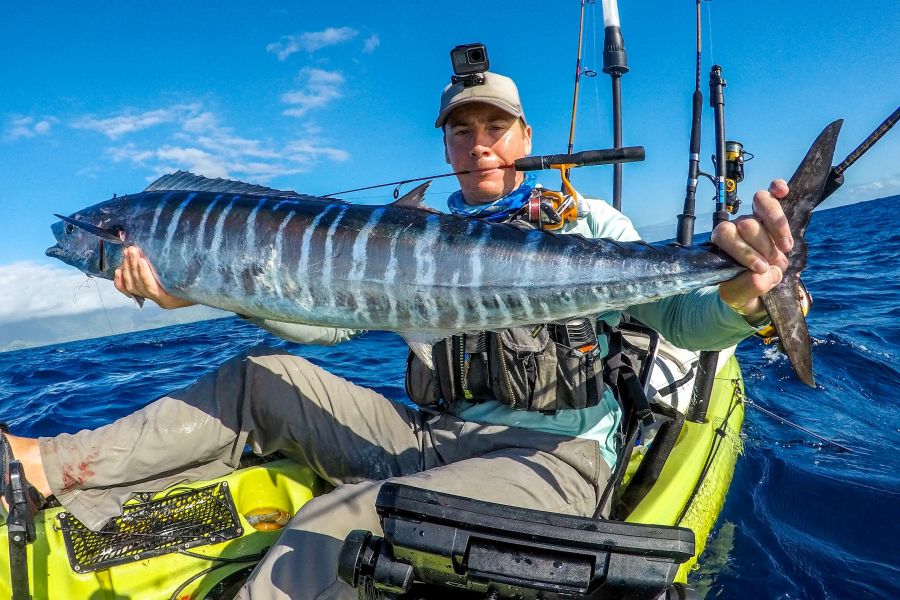
Wahoo are a prize fish for many – Dan is lucky enough to have access these speedsters from his Hobie kayak
Dirty water or near breaking waves provide sharks with a better chance of ambushing prey. Pelagic fish like the clean blue water and so I really don’t spend much time in the powdery green water with the exception of heading in or out. If you know sharks are in the area, they are likely to get your fish before you even see it.
From the kayak, you can’t put a ton of drag on fish because you can easily capsize. Learning to read the fight can often improve your odds. Sharks are supposedly more common during the summer months, but I don’t see sharks often enough to be able to confirm this. As far as the time of day is concerned, I mostly see sharks during the first few hours of the morning.
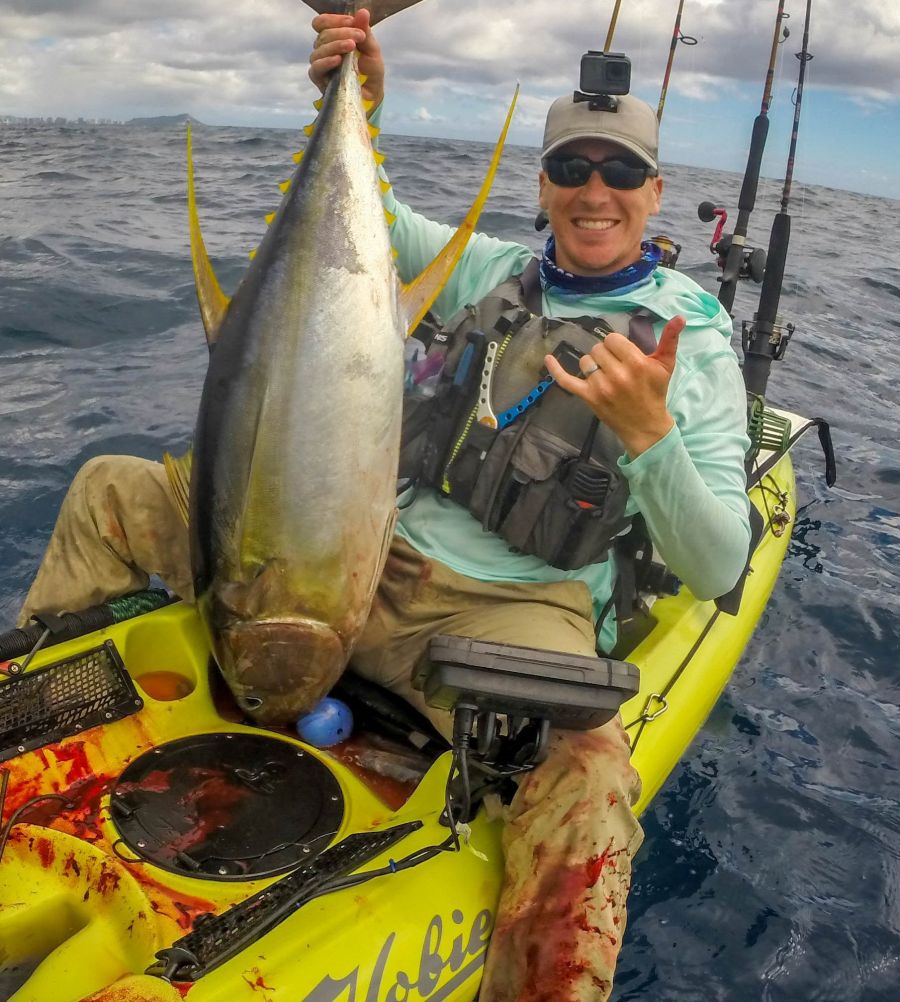
Does Bleeding Your Fish attract Sharks ? Dan does not think so…
I bleed all my fish to improve the quality of the meat. My preferred method is to cut the gills but a well-placed kage gaff shot will get the process started. I have bled a lot of fish, but I have never seen a shark come around because of it. I’m sure one has but it has never gotten close enough for me to see it. I think sharks are much more attracted the sound and vibration of a fish panicking.
Planning for kayak fishing, in general, should prepare you pretty well for dealing with sharks. Aside from safety like sharp knives for cutting lines, pliers, VHF gear my kage gaff (Hawaiian spear gaff) would be my primary tool to deal with an aggressive shark that’s after my fish. Hit it with the handle and then the point if it becomes necessary.
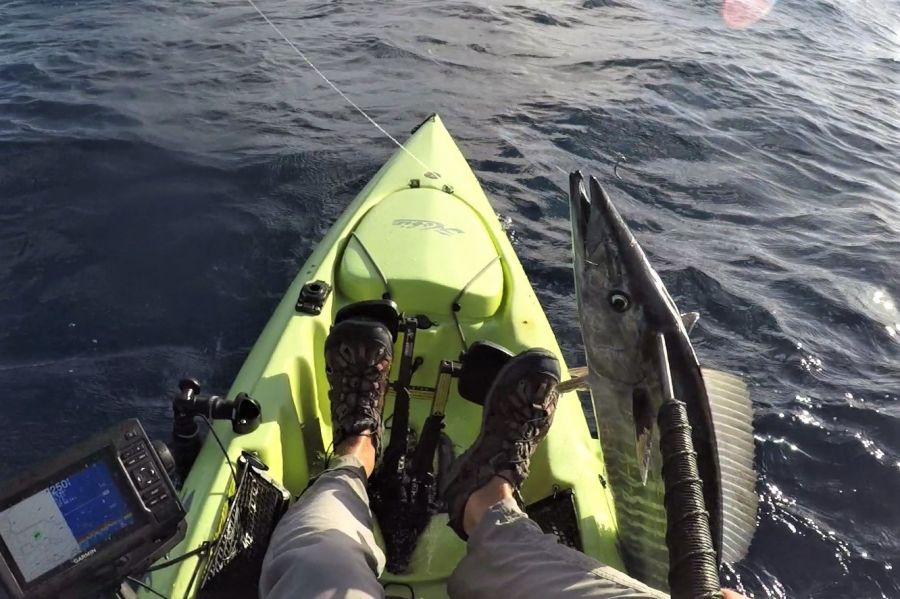
Hawaiian spear comes in just as handy to scare off the sharks as it does to secure the fish
A lot of times live baits will die and they usually end up on the deck of my kayak near scupper holes which can make a shark curious enough to come close. If I needed to I would toss a dead bait in and try moving. Moving a short distance isn’t likely to do anything since a shark can easily match the speed of your kayak and will likely harass the next bait or fish.
From experience, I can tell you that moving less than a half-mile isn’t going to do anything for you. If a shark will simply not leave you alone perhaps its best to move on far away or pack up. It has been suggested that rafting up with other kayaks can deter a shark as you present a larger target and can be more threatening – if in doubt radio for help.
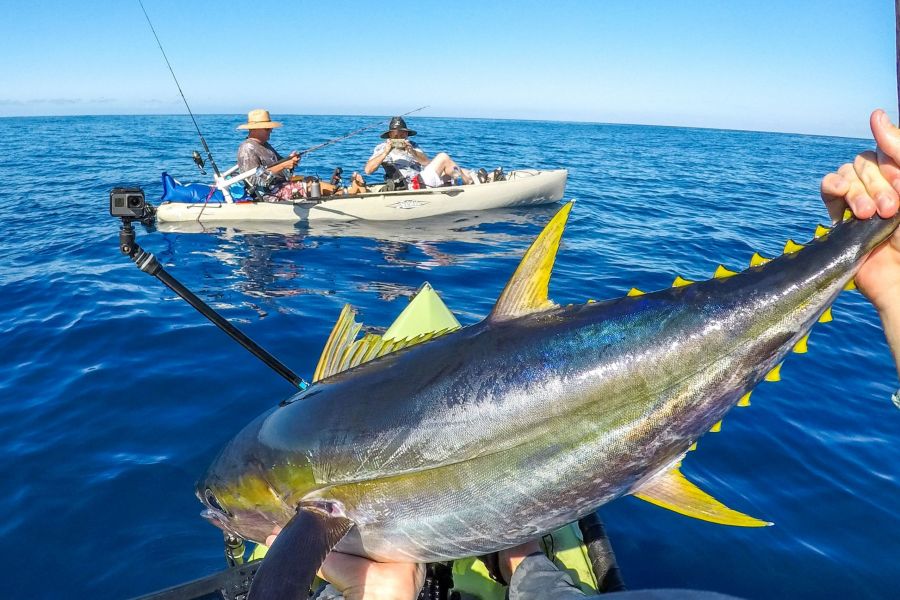
Kayaking in numbers is a good way to deter sharks especially when you raft up together as you present a bigger threat
People call it a float plan/trip plan make sure someone knows where you’re going and when you will be back, let them know if that plan changes well in advance of them having to call for help. Most of the time I am fishing with friends, but if I am going to fish solo I will opt for a safer location with boat traffic in the event I need help.
I don’t like hooking sharks or leaving the hardware in them, but the benefit of using non-stainless hooks is that they will rust out in just a few weeks. I think that sharks, barracuda and needlefish feed on opposite schedules compared to pelagic species. Fish when you can fish but just keep it mind that it might be nothing but sharks. It is only fun catching a shark one time after that it just becomes annoying, I don’t really get the appeal of shark fishing, If I think I am fighting a shark I will tighten my drag and break them off.
Sometimes I manage to hook a sandbar shark perfectly on fluorocarbon line and I am forced to bring it beside the kayak. The smartest thing to do is to cut the line close to the hook rather than risk trying to get your hook back.
At the end of the day we are in their territory and as long as we respect them and have some situational awareness everything will be fine… or not.
Like more Trip Reports & Tackle Tips? Sign up to our Newsletter for regular updates HERE
Check out Dan’s YouTube and Instagram – the quality of the content and his adventures is amazing! links in Dan’s Profile HERE
Kayak Fishing Hawaii Blue Marlin, Wahoo, Yellowfin Tuna all share the same patch with a variety of shark species
